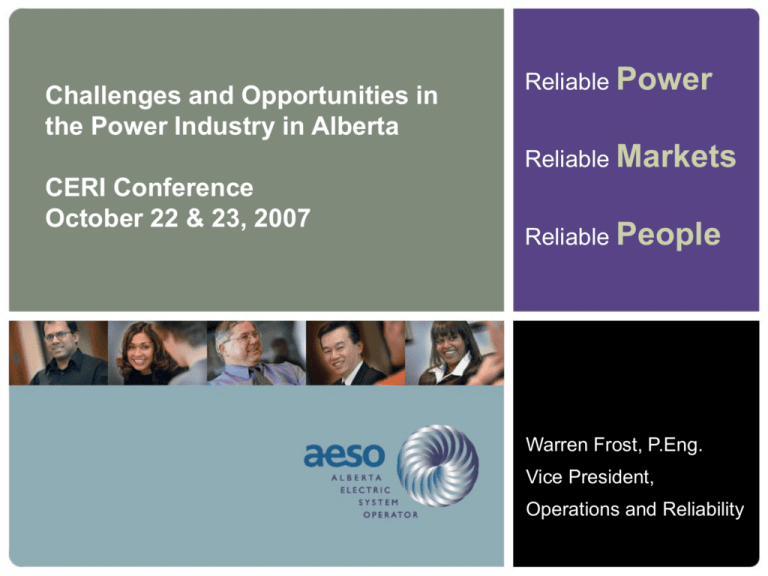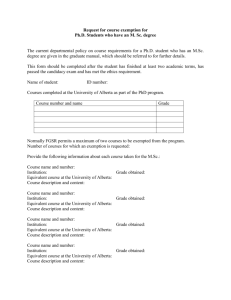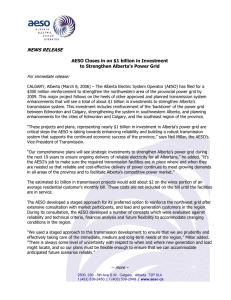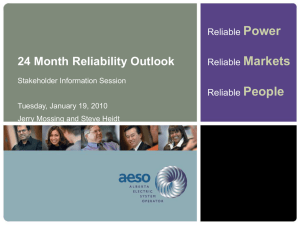Challenges and Opportunities in the Power Industry in Alberta
advertisement

Challenges and Opportunities in the Power Industry in Alberta Reliable Power Reliable Markets CERI Conference October 22 & 23, 2007 Reliable People Warren Frost, P.Eng. Vice President, Operations and Reliability Outline • Quick Facts on Alberta’s electric industry • The Role of the AESO • Challenges in Powering Alberta • Planning and Building Transmission for Tomorrow • Do More with Existing Transmission • Ensuring System Reliability Quick Facts - Alberta’s Electric Industry • 9,661 MW peak & 80% LF • 11,849 MW total generation 5,893 MW 4,412 MW (Wind) 497 MW (Other renewables) BC 178 MW 869 MW • Over 280 generating units • ~ 200 market participants and up to 300 MW of price responsive load • > 21,000 km of transmission • Interties BC (up to 780 MW) & Sask. (up to 150 MW) Alta Sask Alberta Electric System Operator (AESO) • Established in 2003 through the Electric Utilities Act to integrate the Power Pool of Alberta and the Transmission Administrator • Non-profit agency independent of electricity marketplace participants • Governed by an independent board appointed by the Minister of Energy • Regulated by the Alberta Energy and Utilities Board Transmission Tariff Transmission Development and Need Identification Documents • The costs of operating the competitive market are recovered through the Pool Trading Charge and the Transmission Tariff Role of the AESO • Independent System Operator for the Alberta Interconnected Electric System Markets: develop and operate Alberta’s real-time wholesale energy market to facilitate fair, efficient and open competition Transmission System Development: plan and develop Alberta’s transmission system to ensure continued reliability and facilitate the competitive market and investment in new supply Transmission System Access: provide system access for both generation and load customers System Operations: direct the reliable operation of Alberta’s power grid Challenges in Powering Alberta • Alberta is leading North America in load growth Growth in demand is equal to adding two cities the size of Red Deer each year - about 3% per year Adequate supply in the near term but need 3,800 MW by 2016 • Over the last 20 years, power demand in Alberta has doubled but no major upgrades to the transmission backbone! Need transmission to interconnect load and generation for adequate supply and for reliability Challenges to Integrating Wind • Supply-demand balancing is complicated by wind power – wind can increase or decrease rapidly and patterns can be counter to load • Limits to how much wind a system can accommodate – wind needs Supply Demand conventional generation as backup • Transmission upgrades – need upgrades in southern part of the province • Worked with industry to agree on framework and now implementing: Wind forecasting Ramping resources Wind power management Operational rules and tools Wind power and load do not correlate well Transmission Planning – A Long Term View • Need a flexible, reliable and open transmission system wherever suppliers and consumers are located • Transmission must keep pace with Alberta’s resource based economy • Developing new transmission can be challenging: Gas Gas Need to consider a wide range of generation scenarios in a competitive market Take a long term view 10 and 20 year plans Some generation may be built in 18-24 months but transmission may take 5-8 years Need to consult in a comprehensive and open manner on access issues Transmission is critical infrastructure and excellent value Coal •Gas Gas Hydro Coal Wind - Facilitates competitive generation market - $500 million N-S 500 kV line results in about an 70¢/month increase in a "typical" residential consumer's bill Build Transmission • 10-year Transmission System Plan includes $1.2 billion approved with major upgrades underway and $5 billion over the next 10 year period Dover • Major transmission reinforcements in the planning/development stages Marguerite Lake Louise Creek Deerland Whitefish Josephburg Rossdale Clover Bar Wabamun Sagitawah Sundance Bickerdike Keephills Devon Genesee Ellerslie Brazeau Battle River Red Deer Metiskow Cordel Benalto Anderson Sheerness Beddington Langdon h itis Jenner Sarcee E. Calgary Janet Empress Milo lum Co West Brooks bia City of Edmonton reinforcement Southwest and Northwest system reinforcements Hart Lake Mitsue rta be – – McMillan Little Smoky Al • Plans being implemented Brintnel Br Edmonton to Calgary 500-kV reinforcement (refiling) Southeast region for reliability, interconnection of wind generation and restoration of the intertie with Saskatchewan Fort McMurray area meet load growth and to service oilsands Heartland region for planned bitumen upgraders Second Edmonton – Calgary 500 kV Additional Interties and merchant transmission lines Wesley Creek Peigan N. Lethbridge Alberta Montana Alberta an Saskatchew Do More with Existing Transmission • Minor Capital Additions Address equipment issues risers, substation equipment • Improve BC Tie Performance Lightning arrestors, advancing maintenance • Investigate supply and demand options Southern Area Generation TMR or demand side options • Find innovative ways to connect generation Special protection systems/remedial action schemes to connect generators Do More with Existing Transmission • Dynamic thermal line ratings To increase use of existing transmission Currently piloting dynamic line monitoring system in SW region • Real time voltage stability analysis Tool to allow operators to assess voltage stability under all operating conditions • Operating analysis to optimize use of existing transmission assets Do More with Existing Transmission • Phasor Measurement Units (PMUs) to monitor power system vital signs across Alberta Streaming output of voltage and current at 30 samples/second Initiated a project with U of A to study the North South path Researching use of PMU data as a real time indicator of system stability Ensuring System Reliability • Strong emphasis on tools, training and procedures NERC/WECC Audit identified 3 areas of excellence: – Comprehensive Operating Policies and Procedures Manual with thorough revision procedures – Good understanding of voltage issues – study and monitor voltage and reactive resources on AIES – Frequency measurements at all major generation sources to manage islanding conditions Improved ‘real time’ operating tools to improve situational awareness Ongoing system controller training and well defined blackout restoration plans and annual drills (185) Seasonal assessments to address operating issues/optimize use of system • New System Coordination Centre & EMS Ensuring System Reliability • Coordination with Transmission Facility Owners and Generators Comprehensive analysis and followup after disturbances Ensure adequate spares and emergency plans are in place and tested Improve the AESO facilitated process that provides a view of forward view of outages • Compliance Mandatory reliability standards are a means to provide for reliable system operation Mandatory reliability standards will cover all major functions in the electrical industry including cyber security Reliable: 24 . 7. 365 In Summary • There are many challenges ahead for the electric industry and the AESO Need to advance major transmission system reinforcements Heavy demand for customer interconnections Need major investment in new supply Wind Integration Challenging system operations and more extreme weather Continuing evolution of the competitive market for electricity Implementation of mandatory reliability standards • Reliability: it’s our commitment to stakeholders, market participants and Albertans Questions





